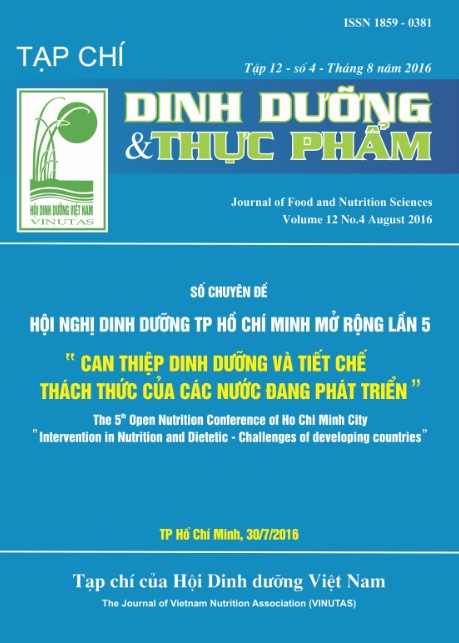INTERVENTIONS FOR HOSPITAL MALNUTRITION IN HO CHI MINH CITY: EVIDENCES FROM LITERATURE, OPPORTUNITIES AND CHALLENGES
Main Article Content
Abstract
The target to improve the quality of health services in Ho Chi Minh City puts many challenges to hospitals within the City. Prevention and treatment of hospital malnutrition in acute care setting are among effective solutions to improve quality of patient care, recovery, cost of treatment, length of hospital stay and mortalities. Hospital malnutrition is not only caused by medical problems and treatment themselves (personal causes) but also by nutritional care of health care facilities (institutional causes). Therefore, for effective malnutrition control of hospitalized patients, solutions should focus on both these group of causes particular food services in hospital.
Keywords
Malnutrition, hospital, nutrition care
Article Details
References
2. Katherine L Hanna et al (2016). Relationship between malnutrition and selected risk factors in two hospitals in Vietnam. Nutrition & Dietetics 2016; 73:59–66.
3. Hogan Danielle et al (2015). Nutritional risk and malnutrition in Vietnamese outpatients with chronic obstructive pulmonary disease (COPD). Respirology 20(Suppl. 2):134 • March 2015.
4. Kubrak, C. and L. Jensen (2007). Malnutrition in acute care patients: A narrative review. International Journal of Nursing Studies, 2007. 44(6): p. 1036-1054.
5. Stratton, R.J., C.J. Green, and M. Elia (2003). Disease-related malnutrition: an evidence-based approach to treatment. Wallingford: CABI.
6. Agarwal, E. (2013). Evaluating nutrition care in Australia and New Zealand acute care hospitals: the Australiasian Nutrition Care day survey in School of Human Movement Studies. The University of Queensland: Australia.
7. Agarwal, E. (2013). Evaluating nutrition care in Australia and New Zealand acute care hospitals: the Australiasian Nutrition Care day survey. School of Human Movement Studies. Australia, The University of Queensland. PhD.
8. Philipson, T., Snider, J., Lakdawalla, D., Stryckman, B. & Goldman, D. (2013). Impact of oral nutritional supplementation on hospital outcomes. The American Journal of Managed Care, 19, 121-128.
9. Watterson, C., Fraser, A., Banks, M., Isenring, E., Miller, M., Silvester, K., et al. (2009). Evidence based guidelines for nutritional management of malnutrition in adult patients across the continuum of care. Nutrition and Dietetics, 66, s1-s34.
10.Kelly A. Tappenden et al (2013). Critical Role of Nutrition in Improving Quality of Care: An Interdisciplinary Call to Action to Address Adult Hospital Malnutrition. JPEN J Parenter Enteral Nutr. 2013;37:482-497.
11.Queensland Health Nutrition Standard for Meals and Menus. (2015) State-wide Foodservices Policy and Planning: Queensland, Australia.
12.Williams, P. and K. Walton (2011). Plate waste in hospitals and strategies for change. The European e-journal of Clinical Nutrition and Metabolism, 2011. 6(6): p. e235-e241.
13.Agarwal, E., et al. (2010). Malnutrition and poor food intake are associated with prolonged hospital stay, frequent readmissions, and greater in-hospital mortality: Results from the Nutrition Care Day Survey 2010. Clinical Nutrition, 2013.32(5): p. 737-745.
14.McBride, E., et al. (2008). Meal and food preferences of nutritionally at-risk inpatients admitted to two Australian tertiary
teaching hospitals. Nutrition & Dietetics, 2008. 65(1): p. 36-40.
15.Food in hospitals-National catering and nutrition specification for food and fluid provison in hospitals in Scotland. 2008,
The Scottish Government: Edinburgh, Scotland.
16.Ferrie, S., S. Rand, and S. Palmer (2013). Back to Basics: Estimating Protein Requirements for Adult Hospital Patients. A Systematic Review of Randomised Controlled Trials.Food and Nutrition Sciences, 2013. 4(2): p. 201-214.
17.Lim, S. L., et al. (2013). Validity and Reliability of Nutrition Screening Administered by Nurses. Nutrition in Clinical Practice 28(6): 730-736.
18.Komindr, S., et al. (2013). Simplified malnutrition tool for Thai patients. Asia Pacific Journal of Clinical Nutrition 22(4): 516-521.


